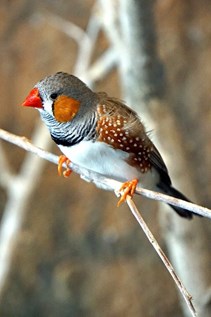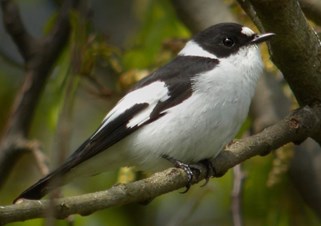Impact of Global Warming on Bird Anatomy and Colour Polymorphism
Friday, June 19, 2020Bird Anatomy
Sandhill cranes are freshwater birds. These omnivorous birds eat insects, aquatic plants, cultivated grains, and, at times, berries, and tubers. Most populations are migratory and winter in southern United States and northern Mexico. During the spring, they migrate north to their summer breeding grounds in much of western Canada and Alaska. Migration often takes places in large flocks of thousands of birds.
The cranes prefer to migrate during the daytime. As the rays of sunlight warm up the ground, the air warms and rises upwards generating thermal uplift which allow the cranes to gain altitude of thousands of feet. The cranes then glide for several kilometers, slowly losing their altitude, before encountering another thermal uplift to regain altitude and repeat the whole process again and again. This process helps the cranes conserve energy, which makes it possible for some birds to travel as far as Siberia for breeding. This remarkable feat is made possible, in-part, by their anatomy, i.e., great wingspan of up to 6 feet. These evolutionary adaptations which allow birds like Sandhill Cranes to migrate long distances are changing in response to climate change.
Bergmann’s rule states that among warm blooded animals, such as birds and mammals, species found in higher latitudes tend to be larger while species occupying lower latitudes tend to be smaller. Bigger body size in higher latitudes, i.e., cold places, allows for better heat retention. This blog will explore the impacts of global warming on colour polymorphism in birds and bird anatomy as explained by Bergmann’s rule.
Climate Change & Bird Anatomy 
The global average temperature has increased by 0.8° Celsius since 1880. Warming temperature has a widespread impact on the North American birds. In one large-scale project, scientists studied the effects of global warming on 52 species of migratory bird in North America.
They inspected over 70,000 museum specimens and found that all species experienced a decline in body size over the last four decades. Simultaneously, nearly all species in the study grew longer wings to compensate for increased energy requirements caused by shrinking body size.
Birds in other parts of the world are also experiencing a decline in body size and mass. The Zebra Finch is native to Australia and it occupies most of the continent. Scientists in Australia examined the effects on temperature on early development of Zebra Finch chicks. As predicted by the Bergmann’s rule, Zebra Finch chicks that hatched during warmer periods had lower body mass compared to chicks hatched during cooler periods.
The anatomical changes caused by the warming temperature have severe consequences for some species. Take European population of Red Knot for example. This medium-sized shore bird has experienced an unparalleled temperature increase due to global warming in its Arctic breeding grounds. As a consequence, the body sizes of newly hatched chicks have decreased over last three decades. Short billed Red Knots, caused by shrinking body size, are unable to dig most nutritious prey thereby decreasing their survival in their wintering grounds in Mauritania. More research is needed to understand the long-term implications of shrinking bird body size.
Climate Change, Colour Variation, & Ornaments in Birds
 Some 3.5% of all the bird species in the world show color polymorphism, i.e., two or more distinct color patterns within a species. Warming temperature and climate change, however, is favoring a particular morph in some polymorphic species. Take the Tawny Owls for example. This European species has two common morphologies with a brown and a grey variant. Scientists observed that as winters became milder over the last few decades, the abundance of brown morph increased. It has been hypothesized that selection for the dark morph under changing climate may be driven by the protection that it provides against UV-radiation and warming temperature.
Some 3.5% of all the bird species in the world show color polymorphism, i.e., two or more distinct color patterns within a species. Warming temperature and climate change, however, is favoring a particular morph in some polymorphic species. Take the Tawny Owls for example. This European species has two common morphologies with a brown and a grey variant. Scientists observed that as winters became milder over the last few decades, the abundance of brown morph increased. It has been hypothesized that selection for the dark morph under changing climate may be driven by the protection that it provides against UV-radiation and warming temperature.
Some bird species are experiencing an even more dramatic change. The Collard Flycatcher is a European songbird. Male Collard Flycatchers have a big white ornamental patch on their forehead. The patch signals to the rivals that you are fearsome rival and a strong companion for a female. Climate change is turning this evolutionary tool on its head. Swedish scientists noticed that, historically, male Collard Flycatchers with larger forehead patches were at an advantage for mating. But, the warming temperature over the decades shrank the forehead patch size and males with bigger forehead patch lost the mating advantage to males with a smaller patch. At the same time, large-patched males became less likely to survive warming winters.
What Can You Do?
You can reduce your carbon footprint and help stop climate change by choosing to drive less. Instead you can bike or walk to places, thus saving money on gas and protecting the environment.
Other helpful tips on how to reduce your carbon footprint to help reduce climate change can be found on our website here.
Picture Credit:
Jayanth Sharma, accessed on June 11, 2020, retrieved from https://upload.wikimedia.org/wikipedia/commons/2/2f/Tawny_Fish_Owl.jpg
Frank Vassen, accessed on June 11, 2020, retrieved from https://commons.wikimedia.org/wiki/File:Ficedula_albicollis,_Bia%C5%82owie%C5%BCa_1.jpg
Dennis Jarvis, accessed on June 11, 2020, retrieved from https://commons.wikimedia.org/wiki/File:DSC09803_-_Zebra_Finch_(36408993773).jpg
Chuck Homler, accessed on June 11, 2020, retrieved from https://commons.wikimedia.org/wiki/File:Red-Knot-for-Wiki.jpg
Additional Readings:
https://www.nationalgeographic.com/animals/birds/s/sandhill-crane/
https://www.allaboutbirds.org/guide/Sandhill_Crane/lifehistory
https://www.audubon.org/field-guide/bird/sandhill-crane
http://online.sfsu.edu/bholzman/courses/Fall%2003%20project/sandhillcrane.htm
https://cranetrust.org/file_download/inline/416bc5d6-5fea-4e10-8bb6-d5e74dfd8b62
https://www.arcgis.com/apps/Cascade/index.html?appid=aaeb93cae44c470ab99abacf4d32ce72
https://onlinelibrary.wiley.com/doi/full/10.1111/j.1466-8238.2010.00577.x
https://www.ncbi.nlm.nih.gov/pmc/articles/PMC4046417/
https://www.fs.usda.gov/ccrc/topics/wildlife/birds
https://animaldiversity.org/accounts/Taeniopygia_guttata/
https://phys.org/news/2016-05-birds.html
https://phys.org/news/2017-01-climate-natural-collared-flycatcher-large.html
Van Buskirk, Josh, Robert S. Mulvihill, and Robert C. Leberman. "Declining body sizes in North American birds associated with climate change." Oikos 119, no. 6 (2010): 1047-1055.
Andrew, S. C., L. L. Hurley, M. M. Mariette, and S. C. Griffith. "Higher temperatures during development reduce body size in the zebra finch in the laboratory and in the wild." Journal of evolutionary biology 30, no. 12 (2017): 2156-2164.
Weeks, Brian C., David E. Willard, Marketa Zimova, Aspen A. Ellis, Max L. Witynski, Mary Hennen, and Benjamin M. Winger. "Shared morphological consequences of global warming in North American migratory birds." Ecology Letters 23, no. 2 (2020): 316-325.
van Gils, Jan A., Simeon Lisovski, Tamar Lok, Włodzimierz Meissner, Agnieszka Ożarowska, Jimmy de Fouw, Eldar Rakhimberdiev, Mikhail Y. Soloviev, Theunis Piersma, and Marcel Klaassen. "Body shrinkage due to Arctic warming reduces red knot fitness in tropical wintering range." Science 352, no. 6287 (2016): 819-821.
Galván, Ismael, Sol Rodríguez‐Martínez, and Luis M. Carrascal. "Dark pigmentation limits thermal niche position in birds." Functional Ecology 32, no. 6 (2018): 1531-1540.
Roulin, Alexandre. "Melanin‐based colour polymorphism responding to climate change." Global Change Biology 20, no. 11 (2014): 3344-3350.
Galeotti, Paolo, Diego Rubolini, Peter O. Dunn, and Mauro Fasola. "Colour polymorphism in birds: causes and functions." Journal of evolutionary biology 16, no. 4 (2003): 635-646.
Karell, Patrik, Kari Ahola, Teuvo Karstinen, Jari Valkama, and Jon E. Brommer. "Climate change drives microevolution in a wild bird." Nature communications 2, no. 1 (2011): 1-7.
Evans, Simon R., and Lars Gustafsson. "Climate change upends selection on ornamentation in a wild bird." Nature ecology & evolution 1, no. 2 (2017): 1-5.
Blog Posts
- What is Climate Change
- Drought: What Can We Do?
- Migration and Climate Change; a Complicated Relationship (Part 1)
- Migration and Climate Change; a Complicated Relationship (Part 2)
- Climate Change and Birds’ Resources
- Ladder to Extinction
- Arctic Warming and Ecosystem Impacts
- Climate Change Connection to Mountain Pine Beetle
- Tackling Climate Change Denialism
- Impact of Climate Change on Bluebirds
- An Introduction to Climate Change
- Great Decline of Aerial Insectivores
- Role of Oceans in Fighting Climate Change
- Role Of Forests In Fighting Climate Change
- Impact of Climate Change on Shorebirds
- Impact of Hurricanes and Climate Change on Birds
- An Introduction to Climate Change.
- Impact of Forest Fires, and Climate Change on the Nature
- Impacts of Climate Change on Owls
- Impacts of Climate Change on Birds of Prey
- Whitebark Pine and Clark's Nutcracker
- COVID 19 & The Environment
- Impact of Global Warming on Bird Anatomy and Colour Polymorphism
- Climate Change & West Nile Virus
- All Posts

